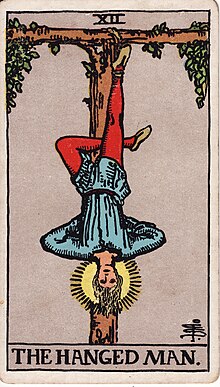
The Hanged Man (XII) is the twelfth Major Arcana card in most traditional tarot decks. It is used in game playing as well as in divination.
It depicts a pittura infamante (pronounced [pitˈtuːra iɱfaˈmante]), an image of a man being hanged upside-down by one ankle (the only exception being the Tarocco Siciliano, which depicts the man hanged by the neck instead). However, the expression on his face traditionally suggests that he is there by his own accord, and the card is meant to represent self-sacrifice more so than it does corporal punishment or criminality.
In other interpretations, The Hanged Man is a depiction of the Norse god Odin, who suspended himself from a tree in order to gain knowledge. There is also a Christian interpretation that portrays Judas Iscariot, and include the bags of silver in his hands. In the Lo Scarabeo African American tarot deck the 12th card of the Major Arcana is the Observer, depicting the Nigerian god "Ifa" of fate and destiny blindfolded and surrounded by eyes.
Description

Modern versions of the tarot deck depict a man hanging upside-down by one foot. The figure is most often suspended from a wooden beam (as in a cross or gallows) or a tree. Ambiguity results from the fact that the card itself may be viewed inverted.
In his 1910 book The Pictorial Key to the Tarot, A. E. Waite, the designer of the Rider–Waite tarot deck, wrote of the symbol:
The gallows from which he is suspended forms a Tau cross, while the figure—from the position of the legs—forms a fylfot cross. There is a nimbus about the head of the seeming martyr. It should be noted (1) that the tree of sacrifice is living wood, with leaves thereon; (2) that the face expresses deep entrancement, not suffering; (3) that the figure, as a whole, suggests life in suspension, but life and not death. It has been called falsely a card of martyrdom, a card of prudence, a card of the Great Work, a card of duty I will say very simply on my own part that it expresses the relation, in one of its aspects, between the Divine and the Universe.
Waite writes that the card carries several divinatory associations:
12. THE HANGED MAN.—Wisdom, circumspection, discernment, trials, sacrifice, intuition, divination, prophecy. Reversed: Selfishness, the crowd, body politic.
There is a halo burning brightly around the hanged man's head, signifying a higher learning or an enlightenment.
References
- ^ Waite (1979).
- Waite (1979), p. 285.
- Gray (1988).
Works cited
- Gray, Eden (1988) . The Tarot Revealed: A Modern Guide to Reading the Tarot Cards. Signet. ISBN 978-0-451-15673-0.
- Waite, Arthur Edward (1979) . The Pictorial Key to the Tarot. New York: Samuel Weiser. ISBN 0-87728-218-8.
Further reading
- Banzhaf, Hajo (2000). Tarot and the Journey of the Hero. Weiser Books. ISBN 978-1-57863-117-9.
- Block, Francesca Lia (1999). The Hanged Man.
- Butler, Bill (1975). Dictionary of the Tarot. New York: Schocken Books. ISBN 0-8052-0559-4.
- Knight, Gareth (1991). The Magical World of the Tarot: Fourfold Mirror of the Universe. Aquarian. ISBN 978-0-85030-940-9.
- Place, Robert (2005). The Tarot: History, Symbolism, and Divination. New York: Penguin Publishing Group. ISBN 978-1-4406-4975-2.
- Pollack, Rachel (1997) . Seventy Eight Degrees of Wisdom: A Book of Tarot. Thorsons. ISBN 978-0-7225-3572-1.
- Wood, Juliette (1998). "The Celtic Tarot and the Secret Tradition: A Study in Modern Legend Making". Folklore. 109 (1–2): 15–24. doi:10.1080/0015587x.1998.9715957.
External links
 Media related to Hanged Man (Major Arcana) at Wikimedia Commons
Media related to Hanged Man (Major Arcana) at Wikimedia Commons
| Occult tarot | |||||||||
|---|---|---|---|---|---|---|---|---|---|
| Occultists | |||||||||
| Major Arcana numbered cards |
| ||||||||
| Minor Arcana suit cards |
| ||||||||
| Decks | |||||||||
| Related | |||||||||